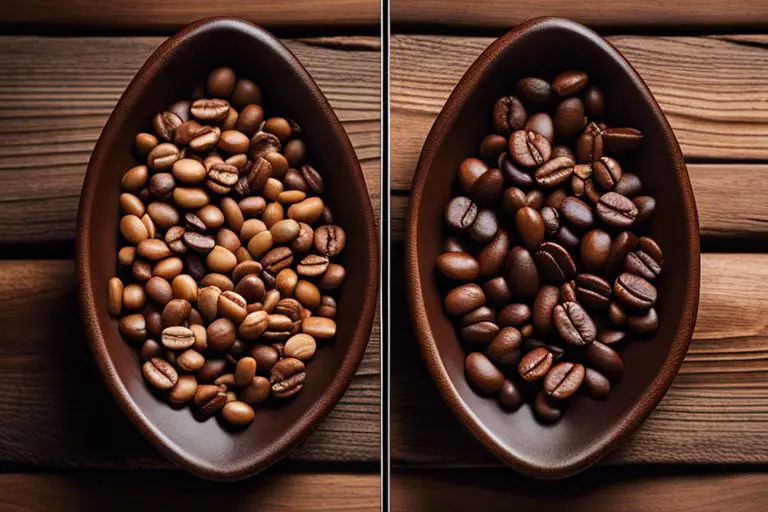Obtain an in-depth understanding of the key disparities between Arabica and Robusta coffee beans in order to enhance your coffee knowledge. Both species are immensely popular in today’s coffee culture, each offering unique attributes that cater to a wide range of coffee enthusiasts. Arabica beans, known for their delicate flavours and acidity, are celebrated for their superior quality, whilst Robusta beans are recognised for their bold, intense taste and higher caffeine content. Familiarize yourself with the distinctive characteristics, growing conditions, and usage of these two types of coffee beans, to elevate your coffee experience and savour the perfect brew time and time again.
Key Takeaways:
- Arabica and Robusta: Arabica and Robusta are the two main types of coffee beans that differ in taste, caffeine content, and growing conditions.
- Taste Profile: Arabica beans are known for their smooth, complex flavour with hints of sweetness and acidity, while Robusta beans have a stronger, more bitter taste with a nutty or woody undertone.
- Caffeine Content: Arabica beans have lower caffeine content compared to Robusta beans, making them a preferred choice for those sensitive to caffeine.
- Growing Conditions: Arabica beans are grown at higher altitudes in cooler climates, while Robusta beans thrive at lower altitudes in hotter, more humid conditions.
- Price and Availability: Arabica beans are generally more expensive and widely available, while Robusta beans are often used in blends and instant coffee due to their affordability and higher caffeine content.
The Origins and Cultivation
When exploring the difference between Arabica and Robusta coffee beans, it’s essential to understand their origins and cultivation. Arabica coffee beans have a rich history, with their origins dating back to the highlands of Ethiopia. This variety is cultivated in various regions across the world, known for its delicate flavour profiles and desirable qualities.
On the other hand, Robusta coffee beans have a different historical root. They are believed to have originated in central and western sub-Saharan Africa. Known for their resilience and strong, bold flavour, Robusta beans are mainly cultivated in Africa and Asia. If you’re curious to learn more about the real-life experiences of tasting Arabica vs Robusta, you can read this insightful Reddit post titled ‘Can I be honest? I tried arabica vs robusta..and prefer …’.
Historical Roots of Arabica and Robusta
The historical roots of Arabica coffee can be traced to the ancient coffee forests of Ethiopia. It is believed that the Arabica plant was first discovered in the region of Kaffa, giving rise to its name. This variety has a long-standing tradition and is often associated with quality and complex flavour profiles, thanks to its cultivation in diverse and unique climates.
Robusta coffee, on the other hand, has historical roots in sub-Saharan Africa. Its cultivation can be traced back to the regions of central and western Africa, where it was discovered growing in the wild. Robusta beans, known for their high caffeine content and resistance to pests, have been crucial to the coffee industry’s sustainability.
Geographical Distribution
The geographical distribution of Arabica coffee is widespread, with suitable climates found in regions across the world. This variety thrives in high-altitude regions, such as Latin America, Africa, and parts of Asia. These unique climates foster the development of the desirable flavour profiles that Arabica is renowned for.
Robusta coffee, on the other hand, is mainly cultivated in regions with lower altitudes, often in humid and warm environments. The primary cultivation regions for Robusta beans include Africa and Asia, where the climate conditions are ideal for its robust growth and development.
It’s important to note that both Arabica and Robusta coffee beans have their unique geographical requirements, contributing to their distinct flavour profiles and qualities.
Botanical Differences
Plant Characteristics
Arabica and Robusta coffee plants have distinct physical differences. Arabica plants are typically taller, reaching heights of up to 5.5 meters, whereas Robusta plants are shorter, reaching around 4.5 meters. The leaves of Arabica plants are also larger and more elongated compared to the smaller and rounder leaves of the Robusta plant. Additionally, Arabica plants tend to be more delicate and susceptible to disease, requiring specific growing conditions, such as higher elevations and consistent rainfall.
On the other hand, Robusta plants are hardier and more resistant to pests and diseases, making them suitable for cultivation in lower altitudes with less demanding growing conditions. They have a greater ability to withstand harsh climates and are often grown in regions where Arabica plants struggle to thrive. These differences in plant characteristics also impact the flavour and quality of the coffee beans that they produce.
Bean Traits and Flavor Profiles
Arabica beans are renowned for their complex and nuanced flavours, with notes of fruit, berries, and floral undertones. They often have a smoother, more mellow taste with higher acidity and less caffeine content. On the other hand, Robusta beans are known for their strong, bold flavour with earthy, woody, and nutty notes. They generally have a harsher, more bitter taste with a higher caffeine content.
Furthermore, Arabica beans typically contain almost 60% more lipids and almost twice the concentration of sugars compared to Robusta beans, which contributes to their more refined and aromatic taste. The differences in bean traits and flavour profiles are influenced by the chemical composition and growing conditions of the plants, making Arabica and Robusta beans distinct in their taste and aroma.
In addition to their flavour profiles, Robusta beans have higher levels of chlorogenic acids, which have been linked to numerous health benefits, including antioxidant properties and potential protection against chronic diseases. While Arabica beans are prized for their superior taste, Robusta beans offer positive health benefits, making them a valuable component in the coffee industry.
Economic and Environmental Impact
When it comes to the economic and environmental impact of Arabica and Robusta coffee beans, there are several key factors to consider. Both types of beans have a significant impact on the livelihoods of coffee farmers, the overall coffee market, and the sustainability of coffee production.
Market Preferences and Pricing
Arabica coffee beans are generally preferred in the specialty coffee market due to their perceived higher quality and more complex flavour profiles. As a result, Arabica beans often command a higher price compared to Robusta beans. On the other hand, Robusta beans are typically used in instant coffee and espresso blends, where their bold and bitter flavour characteristics are desirable. This difference in market preference and pricing has a direct impact on the incomes of coffee farmers and the overall dynamics of the coffee industry.
Farming Practices and Sustainability
Arabica coffee plants are more sensitive to environmental conditions and require specific climate and altitude for optimal growth, often leading to higher production costs. On the other hand, Robusta coffee plants are more resilient and can be grown in a wider range of environments, making them more sustainable in some respects. However, the use of agrochemicals, deforestation, and improper waste management in Robusta farming can have detrimental environmental effects. Therefore, it is crucial for coffee producers to implement sustainable farming practices to mitigate the environmental impact of coffee production.
Overall, the differences in farming practices and sustainability between Arabica and Robusta coffee beans have significant implications for the environmental impact of coffee production. Sustainable practices such as shade-grown cultivation, organic farming, and ethical sourcing can help minimise the negative effects on ecosystems and ensure the long-term sustainability of the coffee industry.
Brewing and Consumption
When it comes to brewing and consumption, the difference between Arabica and Robusta coffee beans becomes evident. Arabica beans are often preferred for their smoother, more delicate flavors, making them ideal for brewed coffee and specialty drinks such as lattes and cappuccinos. On the other hand, Robusta beans are known for their bold, strong flavour and higher caffeine content, making them a popular choice for espresso blends and instant coffee.
Roasting Differences
One of the key differences between Arabica and Robusta coffee beans lies in their roasting process. Arabica beans are typically roasted at a higher temperature and for a longer duration, resulting in a more complex flavour profile with hints of fruit and floral notes. In contrast, Robusta beans are roasted at a higher temperature but for a shorter time, which contributes to their intense, somewhat bitter flavour.
Popular Blends and Uses in Coffee Culture
In coffee culture, Arabica and Robusta beans are often blended together to create a balanced and unique flavour profile. Arabica beans are commonly used in blends for their acidity and fragrant aromas, while Robusta beans are added to enhance the crema and body of the coffee. This combination is frequently used in espresso blends and is popular among coffee enthusiasts who appreciate a bold and flavourful cup.
When selecting a coffee blend, it’s important to consider the ratio of Arabica to Robusta beans, as this will greatly influence the taste and caffeine content of the final product. Understanding the unique characteristics of each bean type is essential for creating a well-balanced and enjoyable coffee experience.
Understanding the Distinction: Arabica vs. Robusta Coffee Beans
In conclusion, it is clear that there are significant differences between Arabica and Robusta coffee beans that go beyond just taste. From the growing conditions to the caffeine content, each variety offers unique characteristics that cater to different preferences and needs. Arabica beans are prized for their delicate flavour profiles and minimal bitterness, making them a popular choice for specialty coffee drinks. On the other hand, Robusta beans are known for their bold, strong flavour and higher caffeine content, making them ideal for espresso blends and instant coffee. Understanding these differences can help coffee enthusiasts make informed choices when selecting their preferred brew. Ultimately, whether you prefer the smooth and aromatic notes of Arabica or the bold and intense flavour of Robusta, both varieties have their own place in the world of coffee.
FAQ
Q: What are the main differences between Arabica and Robusta coffee beans?
A: Arabica and Robusta coffee beans differ in their taste, caffeine content, growing conditions, and price.
Q: How do Arabica and Robusta coffee beans differ in taste?
A: Arabica beans are known for their smooth, mild flavour with a hint of acidity, while Robusta beans have a stronger, more bitter taste.
Q: What is the caffeine content difference between Arabica and Robusta coffee beans?
A: Arabica beans contain less caffeine, typically around 1.5% compared to Robusta beans which can have up to 2.7% caffeine content.
Q: What are the growing conditions for Arabica and Robusta coffee beans?
A: Arabica beans are grown at higher altitudes, in cooler climates with ample rainfall, while Robusta beans thrive at lower altitudes in warmer temperatures with more rainfall.
Q: How does the price of Arabica and Robusta coffee beans compare?
A: Arabica beans are generally more expensive due to their delicate growing conditions and lower caffeine content, while Robusta beans are more affordable and easier to grow.




